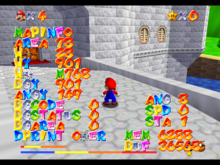| This article needs additional citations for verification. Please help improve this article by adding citations to reliable sources. Unsourced material may be challenged and removed. Find sources: "Debug menu" – news · newspapers · books · scholar · JSTOR (March 2018) (Learn how and when to remove this message) |
A debug menu or debug mode is a user interface implemented in a computer program that allows the user to view and/or manipulate the program's internal state for the purpose of debugging. Some games format their debug menu as an in-game location, referred to as a debug room (distinct from the developer's room type of Easter egg). Debug menus and rooms are used during software development for ease of testing and are usually made inaccessible or otherwise hidden from the end user.
Compared to the normal user interfaces, debug menus usually are unpolished and not user-friendly, intended only to be used by the software's developers. They are often cryptic and may allow for destructive actions such as erasing data without warning.
In video games

Debug menus are often of interest to video game players as they can be used to cheat, access unused content, or change the game configuration beyond what is normally allowed. Some game developers will reveal methods to access these menus as bonus features, while others may lock them out of the final version entirely such that they can only be accessed by modifying the program.

The Cutting Room Floor (TCRF) is a website dedicated to researching and documenting hidden content in video games, including debugging material. In December 2013, Edge described the website as "the biggest and most organised" of its kind, and by that time it had 3712 articles.
In other software
Debugging functions can be found in many other programs and consumer electronics as well. For example, many TVs and DVD players contain hidden menus that can be used to change settings that aren't accessible through the normal menus. Many cell phones also contain debug menus, usually used to test out functions of the phone to make sure they are working. For example, the hidden menu of the Samsung Galaxy S III has test functions for the vibrator, proximity sensor, sound, and other basic aspects of the phone.
References
- Jeff Ramos (17 August 2017). "How to access and use Sonic Mania's debug mode". Polygon. Retrieved 26 March 2018.
- Jack Yarwood (29 March 2016). "The People Obsessed With Uncovering Gaming's Deepest, Darkest Secrets". Kotaku. Retrieved 26 March 2018.
- "The Explorers: The gaming archaeologists digging through the code you were never meant to see". Edge. 16 December 2013. Archived from the original on 18 February 2014. Retrieved 26 March 2018.
- The Cutting Room Floor - The Cutting Room Floor is a site dedicated to unearthing and researching unused and cut content from video games. From debug menus, to unused music, graphics, enemies, or levels, many games have content never meant to be seen by anybody but the developers — or even meant for everybody, but cut due to time/budget constraints. https://tcrf.net/
- Skies of Arcadia Dreamcast prototype V0.830 2000/09/05 (sous réserve ) +V0.840 2000/09/14 (sous réserve ) https://www.dreamcastsegainfo.org/skies-of-arcadia-v0-830-2000-09-05